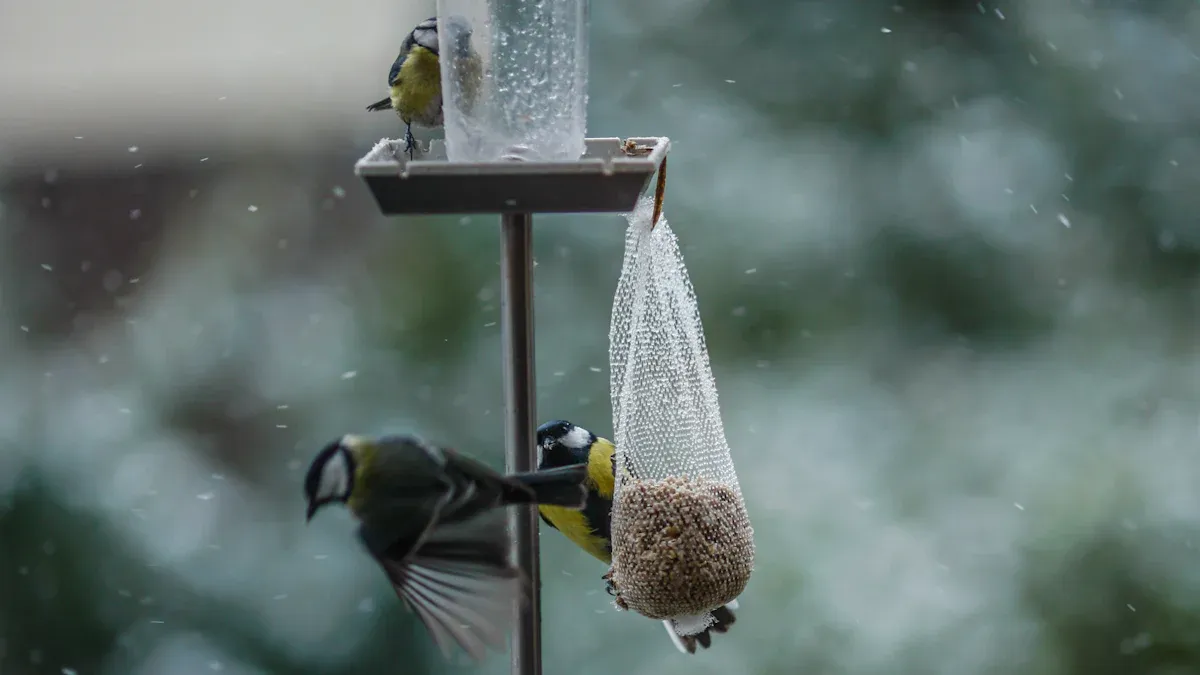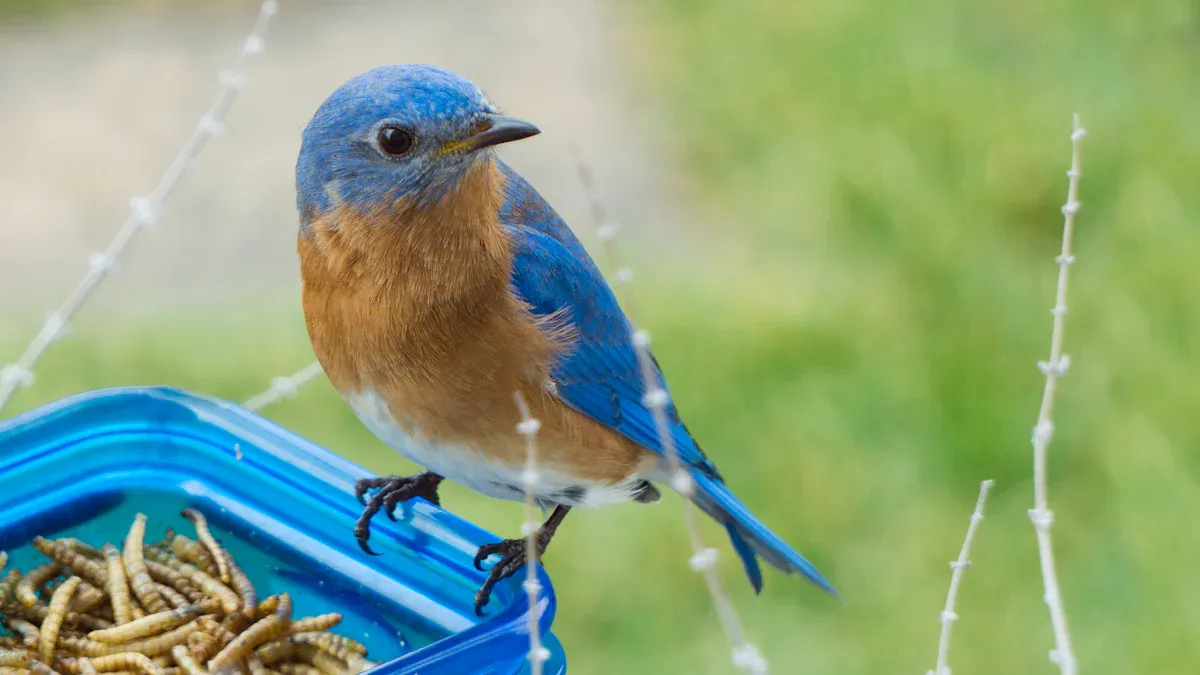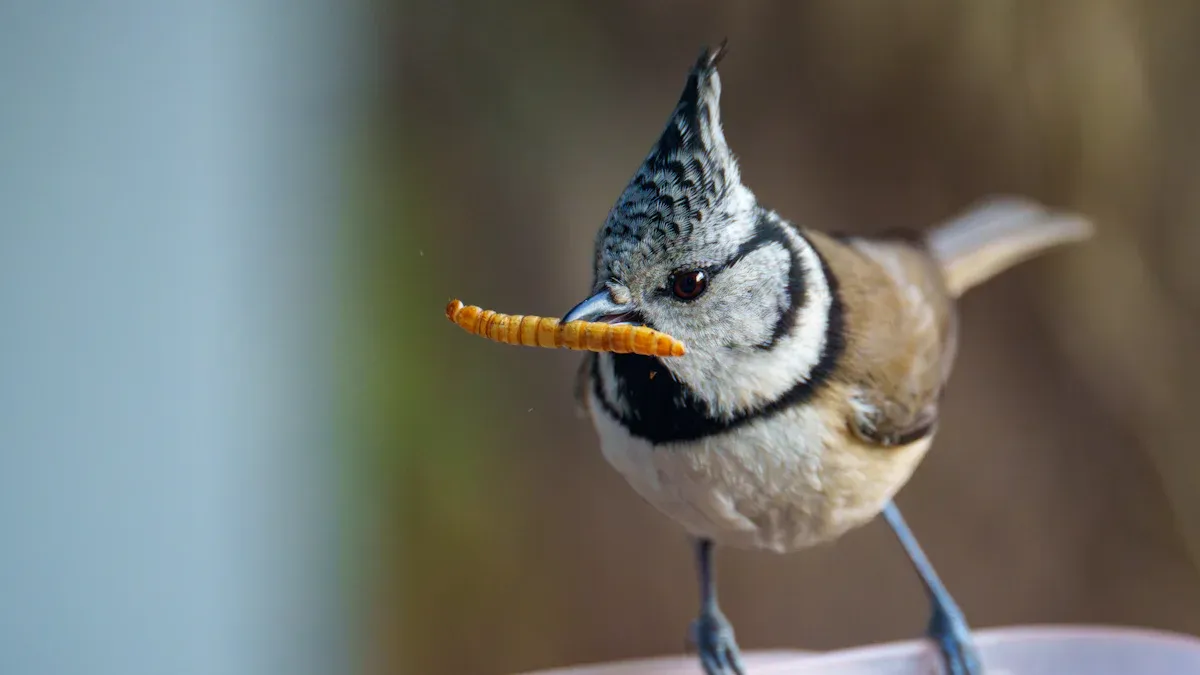
Winter can be tough for birds. Food sources like insects and larvae disappear, leaving them struggling to find enough energy to stay warm. That’s where dried mealworms for birds come in. Packed with protein and calories, they provide the fuel birds need to survive the cold. Plus, they’re easy to store and use!
Key Takeaways
- Dried mealworms are full of protein and give birds energy.
- They help birds stay warm in the cold winter months.
- Mealworms are simple to store and last a long time.
- This makes them a handy choice for feeding birds.
- Feeding mealworms brings many bird types to your yard.
- It also makes birdwatching more fun and exciting.
Nutritional Value of Dried Mealworms for Birds

High Protein for Energy and Warmth
When winter hits, birds need extra energy to stay warm, and that’s where dried mealworms shine. These little powerhouses are packed with protein—about 50% to 55%, to be exact. Protein provides essential amino acids that help birds maintain their energy levels and body warmth during cold weather.
Here’s why this matters:
- Protein acts as a fuel source, giving birds the energy they need to forage and survive.
- It helps them generate body heat, which is critical when temperatures drop.
- The high protein content ensures birds can meet their increased energy demands in winter.
By offering dried mealworms for birds, you’re giving them a reliable source of energy to thrive, even in the harshest conditions.
Rich Fat Content for Sustained Energy
Dried mealworms don’t just stop at protein—they’re also rich in fat, with a crude fat content of 24-25%. Fat is an essential nutrient for birds, especially in winter, when they need sustained energy to keep going.
Here’s how the fat in dried mealworms helps:
- It provides a concentrated source of calories, perfect for meeting birds’ heightened energy needs.
- Fat helps birds maintain their body temperature, ensuring they stay warm and active.
This combination of protein and fat makes dried mealworms a winter superfood for your feathered visitors.
Additional Nutrients for Overall Health
Dried mealworms aren’t just about protein and fat—they’re also packed with vitamins and minerals that support overall bird health. These nutrients improve feather quality, boost vitality, and even enhance egg production in some species. By feeding dried mealworms to birds, you’re giving them a well-rounded diet that keeps them healthy and strong throughout the winter months.
Benefits of Dried Mealworms in Winter
Supporting Birds During Food Scarcity
Winter can be a tough time for birds. Natural food sources like insects and seeds become scarce, leaving birds struggling to find enough to eat. This is where dried mealworms for birds come to the rescue. They’re packed with protein and calories, giving birds the energy they need to survive.
Here’s why dried mealworms are so helpful during food shortages:
- They provide a high protein content, essential for maintaining energy levels.
- Their concentrated calories help birds meet their increased energy demands.
- They’re especially beneficial for migratory species and year-round residents.
Unlike live insects, dried mealworms are easy to store and have a long shelf life. This means you can always have them on hand to support your feathered friends when food is hard to find.
Helping Birds Maintain Body Heat
Staying warm in winter is no small feat for birds. They need high-energy foods to generate heat and keep their bodies functioning. Dried mealworms are perfect for this. Their high protein and fat content provide the fuel birds need to maintain their body temperature.
Here’s how they help:
- Protein supplies essential amino acids for energy production.
- Fat offers a concentrated source of calories, keeping birds warm and active.
By offering dried mealworms, you’re giving garden birds the energy boost they need to survive the cold. This simple act can make a big difference in their ability to thrive during harsh weather.
Boosting Energy for Migratory Birds
Migratory birds face unique challenges in winter. They need extra energy to prepare for long-distance flights and to stay warm when food is scarce. Dried mealworms are a lifesaver for these birds. Packed with protein, vitamins, and minerals, they provide the nutrients birds need for their daily activities and migration.
The high protein content in dried mealworms helps migratory birds build strength and maintain energy levels. The concentrated calories ensure they can meet the demands of cold weather and long journeys. By feeding dried mealworms to migratory birds, you’re helping them stay strong and ready for their next adventure.
Birds That Enjoy Dried Mealworms

Common Backyard Birds That Feed on Mealworms
You might be surprised by how many backyard birds love dried mealworms. These protein-packed treats attract a variety of species that frequent your garden. Here’s a quick list of common birds you can expect to see enjoying them:
- Bluebirds
- Chickadees
- Thrushes
- Titmice
- Wrens
- Nuthatches
- Kinglets
By offering dried mealworms, you’re not just feeding birds—you’re creating a lively, bustling backyard filled with chirping and fluttering activity. It’s a win-win for you and your feathered friends!
Attracting Insect-Eating Birds
If you’re hoping to attract insect-eating birds, dried mealworms are your best bet. Birds like bluebirds, robins, and even blue tits can’t resist these nutrient-rich snacks. Why? Because dried mealworms mimic their natural diet, especially during winter when insects are scarce.
These little treats are packed with protein, which helps birds maintain their energy levels and stay warm. They also provide a concentrated source of calories, which is essential for survival in cold weather. By adding dried mealworms to your feeder, you’ll not only attract a diverse range of birds but also help them thrive during the harshest months.
Tip: Place your feeder in a quiet spot to make insect-eating birds feel safe while they enjoy their mealworms.
Why Mealworms Are a Versatile Option
Dried mealworms for birds are incredibly versatile. They appeal to a wide range of species, from robins and blackbirds to nuthatches and blue tits. Whether you’re a seasoned birdwatcher or just starting out, mealworms are a fantastic choice for attracting a variety of birds to your garden.
Here’s why they’re so practical:
- They cater to many bird species, making them a universal favorite.
- They’re easy to store and don’t require refrigeration.
- Unlike live insects, they won’t escape from feeders, keeping your feeding area clean.
Dried mealworms also offer a concentrated source of calories, helping garden birds meet their heightened energy requirements during winter. This boost is crucial for maintaining body temperature and ensuring their survival against the cold. With so many benefits, it’s no wonder mealworms are a go-to option for bird enthusiasts everywhere.
Feeding and Storing Dried Mealworms
Choosing the Right Feeder
Picking the right feeder for dried mealworms can make a big difference in attracting birds and keeping the feeding area clean. You’ll want a feeder that’s both practical and bird-friendly. Here are some features to look for:
- Use a smooth dish or cup to prevent mealworms from escaping.
- Choose a feeder that’s easy to clean since you’ll need to refill it often.
- Opt for a design that allows birds to land comfortably and gives you a clear view for birdwatching.
For even more convenience, consider feeders with these features:
| Feature | Description |
|---|---|
| Tall sides | Keeps mealworms from crawling out. |
| Roof or baffle | Protects mealworms from rain, preventing mold or sogginess. |
| Drainage holes | Lets water escape, keeping mealworms dry. |
| Tamper-resistant features | Stops squirrels and pests from stealing the mealworms. |
These thoughtful designs ensure your feathered friends get their mealworms while keeping waste and mess to a minimum.
Proper Storage Tips
Storing dried mealworms correctly is key to maintaining their freshness and nutritional value. Here’s how you can do it:
- Keep them in an airtight container to lock in freshness.
- Store the container in a cool, dry place to prevent mold growth.
- Check regularly for moisture, mold, or bad odors, which are signs of spoilage.
Avoid common mistakes like overcrowding the container, which can cause heat buildup. Also, clean the container often to prevent bacteria or pests from ruining the mealworms. By following these tips, you’ll always have fresh, nutritious mealworms ready for your backyard birds.
Best Times to Feed Birds in Winter
Timing matters when feeding birds during winter. Birds burn a lot of energy staying warm, so offering dried mealworms at the right time can make a big difference. Early morning is ideal since birds need an energy boost after a cold night. You can also refill feeders in the late afternoon to help them prepare for the evening chill.
Dried mealworms offer a concentrated source of calories, helping garden birds meet their heightened energy requirements during winter. This boost is crucial for maintaining body temperature and ensuring their survival against the cold. By feeding them at the right times, you’re giving them the best chance to thrive in harsh weather.
Dried mealworms are a game-changer for winter bird feeding. They provide essential amino acids and a concentrated source of calories, helping birds stay warm and energized when food is scarce. Plus, they’re easy to store and attract a variety of species, making your backyard a lively haven for birdwatching.
By feeding dried mealworms, you’re not just helping birds survive—you’re supporting local bird populations and creating a vibrant ecosystem. Watching diverse species thrive in your garden is a rewarding experience that connects you to nature. So why wait? Start feeding dried mealworms today and enjoy the beauty of winter birds up close!
FAQ
What makes dried mealworms better than live ones for winter feeding?
Dried mealworms are easier to store, last longer, and don’t escape from feeders. Plus, they still provide the same protein and calorie boost birds need.
How often should I feed dried mealworms to birds in winter?
Offer them daily, especially in the morning and late afternoon. Birds need energy after cold nights and before evening chills set in.
Can all birds eat dried mealworms?
Most birds can enjoy them, but insect-eating species like bluebirds, robins, and wrens love them the most. They’re a versatile option for attracting diverse birds.


